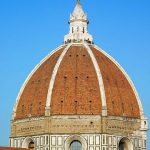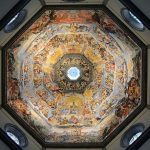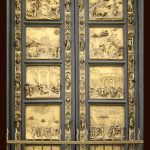From the Archives: Climbing Brunelleschi’s Dome
Sometimes life makes it impossible to write blog posts on a dependable basis. This is one of the those times. For the next little while, I’m going to run pieces from September and October in years past. I hope you enjoy them, and I’ll be back as soon as I can.
Next up, a post from October, 2016:
One of the first things My Own True Love and I did in Florence was visit Brunelleschi’s dome.* I suspect we are not alone in making that choice.
The first thing you need to know about visiting the Duomo is that it is part of a complex of impressive buildings, made up of the cathedral, of which the dome is a part, the baptistry,** a bell tower designed by Giotto, and a museum on the site of the original works of the cathedral (think construction office and artist workshops.) Depending on what you decide to do, you could spend the better part of two days on the complex—there’s a reason the ticket is good for two days. We decided to climb into the dome, tour the museum, and see the dome from inside the cathedral. Here are the highlights:
- If you know me in real life, you know that climbing up into the dome is a Big Deal. I have a bum knee and a bum lung and don’t much like heights. I have refused to climb many many staircases over the years, including fire towers, lookout points,and the Washington Monument. My Own True Love asked several times to be sure I understood what line we were in and what we were planning to do. The hour and a half wait** and the 463 steps were worth it. The stairs are narrow, some of them are spiraled, and the last bit was more like a ladder than a staircase. But it was very cool to see the structure between the inner and outer dome and breathtaking to see Giorgio Vasari’s frescoes of the Last Judgment up close.
- The cathedral interior is awe inspiring, even though we didn’t get a good view of the dome from below. (The central aisle was blocked off. ) The simplicity of the space surprised us. We had Gothic cathedrals and Baroque churches in our heads.
- The museum was a mixed bag. In my nerdy way, I had expected a museum named after the works of the Duomo to have exhibits on 14th and 15th century construction techniques. The entrance to the museum reinforced that impression: a long marble wall with the names of some of the thousands of men who worked on the Duomo over the years, masons and carpenters as well as architects and painters. Once inside, the focus shifted from “humble tradesmen”**** to architects and from construction to design. Much of the exhibition was illuminating. But by the end, I was too brain dead to appreciate the artistry behind embroidered Renaissance vestments and silver and gold altar pieces. I’m not sure I would ever have cared about 19th century arguments over restoring the facade to its original Gothic style. On the other hand, seeing Ghiberti’s original bronze doors to the baptistry was thrilling.
- I got a giggle over the fact that Donatello’s sculpture of the Prophet Habakkuk—considered one of the most important sculptures of the period— is popularly known as Zuccone (Pumpkin Head). Evidently the impulse that led Chicago’s citizens to call Anish Kapoor’s beautiful sculpture The Bean (instead of its official title Cloud Gate) is not new.
*Several weeks ago, I mentioned in passing that I planned to re-read Ross King’s book about the dome on our trip to Florence in anticipation of seeing the Duomo in real life. The book traveled with me to Florence, but I haven’t opened it. Instead I’ve been reading Sarah Gristwood’s newest book about sixteenth century European queens, coming soon to a blog post near you.
**One of the oldest buildings in Florence and predating the Duomo by hundreds of years/
***There are ways to skip the line, none of which worked for us. The steps are not avoidable. Think twice is you have heart trouble, claustrophobia or other ailments.
****Their phrase, not mine.







